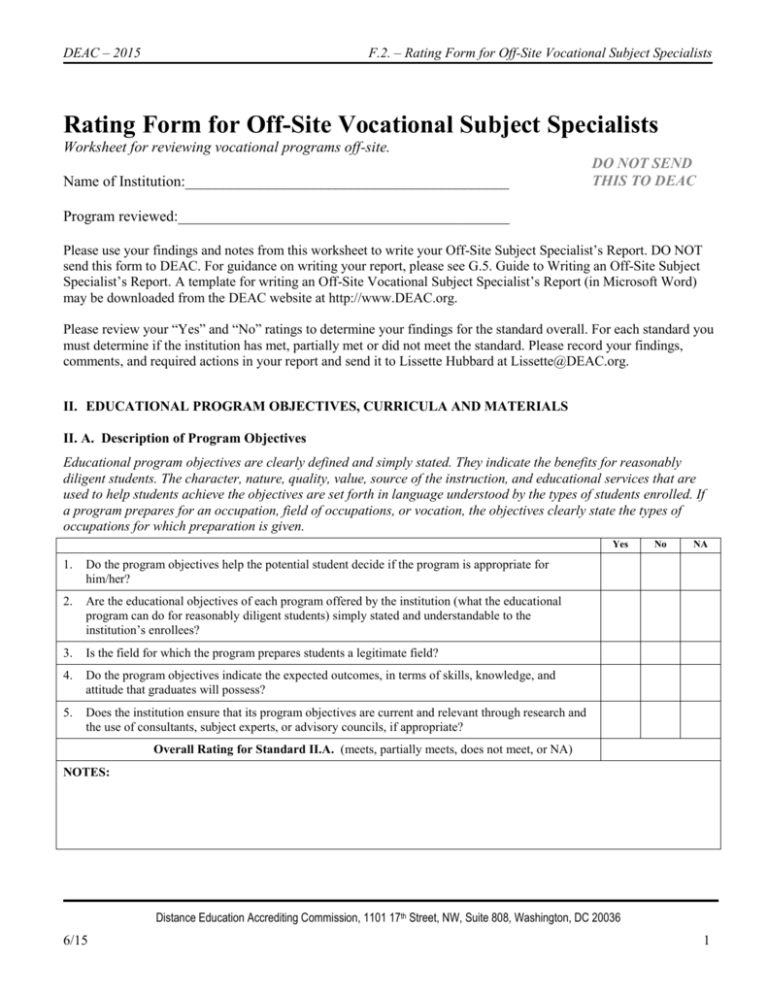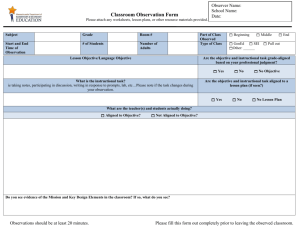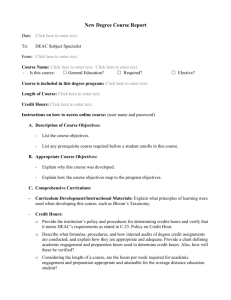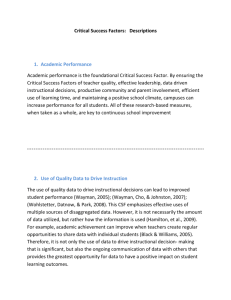F.2. Rating Form for Off-Site Vocational Subject Specialists
advertisement

DEAC – 2015 F.2. – Rating Form for Off-Site Vocational Subject Specialists Rating Form for Off-Site Vocational Subject Specialists Worksheet for reviewing vocational programs off-site. Name of Institution:___________________________________________ DO NOT SEND THIS TO DEAC Program reviewed:____________________________________________ Please use your findings and notes from this worksheet to write your Off-Site Subject Specialist’s Report. DO NOT send this form to DEAC. For guidance on writing your report, please see G.5. Guide to Writing an Off-Site Subject Specialist’s Report. A template for writing an Off-Site Vocational Subject Specialist’s Report (in Microsoft Word) may be downloaded from the DEAC website at http://www.DEAC.org. Please review your “Yes” and “No” ratings to determine your findings for the standard overall. For each standard you must determine if the institution has met, partially met or did not meet the standard. Please record your findings, comments, and required actions in your report and send it to Lissette Hubbard at Lissette@DEAC.org. II. EDUCATIONAL PROGRAM OBJECTIVES, CURRICULA AND MATERIALS II. A. Description of Program Objectives Educational program objectives are clearly defined and simply stated. They indicate the benefits for reasonably diligent students. The character, nature, quality, value, source of the instruction, and educational services that are used to help students achieve the objectives are set forth in language understood by the types of students enrolled. If a program prepares for an occupation, field of occupations, or vocation, the objectives clearly state the types of occupations for which preparation is given. Yes 1. Do the program objectives help the potential student decide if the program is appropriate for him/her? 2. Are the educational objectives of each program offered by the institution (what the educational program can do for reasonably diligent students) simply stated and understandable to the institution’s enrollees? 3. Is the field for which the program prepares students a legitimate field? 4. Do the program objectives indicate the expected outcomes, in terms of skills, knowledge, and attitude that graduates will possess? 5. Does the institution ensure that its program objectives are current and relevant through research and the use of consultants, subject experts, or advisory councils, if appropriate? No NA Overall Rating for Standard II.A. (meets, partially meets, does not meet, or NA) NOTES: Distance Education Accrediting Commission, 1101 17th Street, NW, Suite 808, Washington, DC 20036 6/15 1 F.2. – Rating Form for Off-Site Vocational Subject Specialists DEAC – 2015 II. B. Appropriate Program Objectives Standard: The program objectives must be reasonably attainable through electronically delivered, online, or other methods of distance study. Appropriate objectives include the development of skills, providing job-related training, the imparting of knowledge and information, the training in the application of knowledge and skills, and the development of desirable habits and attitudes. Evaluation of the program is based on the announced objectives and the success with which students achieve the objectives. Yes 1. Are the program objectives and learning outcomes achievable through the distance study method? 2. Are the program objectives appropriate for the subjects taught? 3. Are the program objectives comparable to similar program objectives offered by a traditional institution of the same nature and level? 4. Do the program objectives include the development skills, providing job-related training, the imparting of knowledge and information, the training in the application of knowledge and skills, and the development of desirable habits and attitudes? 5. Are the program objectives up-to-date? 6. Is the evaluation of the program(s) based on the announced objectives and the success with which students achieve those objectives? No NA Overall Rating for Standard II.B. (meets, partially meets, does not meet, or NA) NOTES: II. C. Comprehensive Curriculum (or program of instruction) The curriculum is sufficiently comprehensive for students to achieve the stated program objectives and its content is supported by sound research and practice. An institution has policies and procedures for determining credit hours as defined in C.9. Policy on Degree Programs and/or clock hours it awards for its courses and/or programs. Yes 1. Will students who complete the program learn enough to achieve the program objectives? 2. Did the institution explain what principles of learning are used, such as Bloom’s taxonomy, and what appropriate instructional design models are used, such as ADDIE, when the curriculum is developed? 3. Do the instructional materials have sufficient depth for the student to master the subject? 4. If employment opportunities were suggested in the institution’s advertisements, catalogs, and/or program objectives, would the student be properly trained for employment? 5. Does the institution’s policy and procedures for determining the number of clock hours assigned to each program adequate and appropriate? 6. Are the clock hours required comparable to programs offered by accredited resident institutions? No NA Overall Rating for Standard II.C. (meets, partially meets, does not meet, or NA) Distance Education Accrediting Commission, 1101 17th Street, NW, Suite 808, Washington, DC 20036 2 6/15 DEAC – 2015 F.2. – Rating Form for Off-Site Vocational Subject Specialists II. D. Up-to-Date Curriculum (“Curriculum” is the program of instruction) The curriculum/curricula reflect(s) current knowledge and practice. Effective procedures are used continuously to keep it/them up-to-date. Internal course/program reviews are conducted on a periodic basis. Yes 1. Does the program curriculum reflect current knowledge and practice? 2. Are effective procedures used continuously to keep it/them up-to-date? 3. Are internal course/program reviews conducted on a periodic basis? No NA Overall Rating for Standard II.D. (meets, partially meets, does not meet, or NA) NOTES: II. E. Comprehensive and Up-to-Date Instructional Materials (“Instructional Materials” are the components that make up the curriculum or program of instruction) Standard: Instructional materials are sufficiently comprehensive to enable students to achieve the announced program objectives. The instructional materials are accurate and reflect current knowledge and practice and are regularly reviewed and revised. Yes 1. Are instructional materials sufficiently comprehension to enable students to achieve the announced program objectives? 2. Do the instructional materials prepare students to meet any employment opportunities and/or profession stated or implied in the institution’s advertisements, catalogs, websites, and/or program objectives? 3. Do the instructional materials allow students to meet their learning goals? 4. Do the instructional materials reflect current knowledge and practice? No NA Overall Rating for Standard II.E. (meets, partially meets, does not meet, or NA) NOTES: Distance Education Accrediting Commission, 1101 17th Street, NW, Suite 808, Washington, DC 20036 6/15 3 F.2. – Rating Form for Off-Site Vocational Subject Specialists DEAC – 2015 II. F. Examinations and Other Assessments Standard: Examinations and other assessment techniques are adequate evidence of the achievement of the stated learning objectives and outcomes. The institution must publish its academic grading policies, assignment marking system, course extension policy, and information on issuance and completion of incomplete grades, and apply them with fairness and consistency. Yes 1. Are the types of test items selected appropriate for what they are designed to measure? 2. Are the number and length of examinations adequate to determine if sufficient student mastery of course objectives have taken place? 3. Are methods used for submitting exams appropriate? 4. Do the required learning activities/assignments measure the student’s ability to master and apply skills or knowledge that are stated as outcomes for the course/program? 5. Do the exams and other assignments measure the achievement of announced objectives and outcomes? 6. Does the institution’s procedures ensure that grades are applied with fairness and consistency? 7. Do subjective exams/projects measure the student’s ability to apply skills that are taught in the lessons? 8. Are the evaluation tools used to assess student achievement and mastery of the course objectives appropriate? No NA Overall Rating for Standard II.F. (meets, partially meets, does not meet, or NA) NOTES: II. G. Authorship Standard: Qualified persons competent in distance study techniques and in their subjects or fields develop the curriculum content and prepare instructional materials. Yes 1. If study guides (print and non-print) are used, are they appropriately prepared for use with standard texts? 2. If textbooks are used, are they suitable for distance study (current, adequate, recognized as a standard for the field for the subject being taught)? 3. If textbooks are used, are they appropriate (current, adequate, recognized as a standard in their field, etc.) for the subject being taught? 4. Do the instructional materials appear to be written by qualified and knowledgeable people? No NA Overall Rating for Standard II.G. (meets, partially meets, does not meet, or NA) Distance Education Accrediting Commission, 1101 17th Street, NW, Suite 808, Washington, DC 20036 4 6/15 DEAC – 2015 F.2. – Rating Form for Off-Site Vocational Subject Specialists II. H. Organization of Instructional Materials Standard: The organization and presentation of the instructional materials are in accord with sound principles of learning and grounded in sound instructional design principles. Yes 1. Does the organization and presentation of the instructional materials use various levels of learning, such as Bloom’s taxonomy, and an appropriate instructional design, such as ADDIE? 2. Is the content of the program broken into manageable parts or segments for convenient study sessions? 3. Are the lessons organized in such a way that the student can arrange appropriate individual study sessions? 4. Are students required to submit an appropriate number of assignments to adequately evaluate their knowledge, skills and aptitude of the subject? No NA Overall Rating for Standard II.H. (meets, partially meets, does not meet, or NA) NOTES: II.I. Curriculum Delivery Standard: Online and/or written instructional materials are appropriately presented. Online materials fit the content and are delivered using readily available, reliable technology. Institutional prepared materials must be keyed to the reading competence of the students in the program and be legibly reproduced. Yes 1. Are the instructional materials appropriately presented? 2. Do the online materials fit the content and are the materials readily available? 3. Are the materials properly edited for typos, grammar, etc.? 4. For electronically delivered programs, are the instructional materials appropriately presented? 5. When technology is used for any part of the program, is training and support in the use of that technology provided for students, faculty, and involved practitioners? 6. Are institution-prepared lesson booklets appropriately presented for use in an individual study session? 7. Is the commercially prepared text appropriate for the distance education program? 8. Does the reproduction of text material adequately enhance the educational function of the program? 9. Are the institutional prepared materials appropriately keyed to the reading competence of the students in the program? No NA 10. Will the materials and size of shipments hold up under UPS, USPS, or other shipping methods? 11. Does the institution appropriately use print material to complement its online programs? Overall Rating for Standard II.I. (meets, partially meets, does not meet, or NA) Distance Education Accrediting Commission, 1101 17th Street, NW, Suite 808, Washington, DC 20036 6/15 5 F.2. – Rating Form for Off-Site Vocational Subject Specialists DEAC – 2015 II. J. Study Instructions Standard: Instructions and suggestions on how to study and how to use the instructional materials assist students to learn effectively and efficiently. Yes 1. Are instructions to students on how to proceed through the program adequate and clearly written? 2. Are instructions to students on how to study the program adequate and clearly written? 3. Is the institution-initiated guidance or remediation given to students proceeding through the program sufficient? 4. For online courses, are the instructions adequate on how to access chat rooms, bulletin boards, and other appropriate resources? No NA Overall Rating for Standard II.J. (meets, partially meets, does not meet, or NA) NOTES: II. K. Educational Media and Learning Resources Standard: Learning resources for faculty and students must be available and appropriate to the level and scope of program offerings. Program designers and/or faculty/instructors make effective use of appropriate teaching aids and learning resources, including educational media and supplemental instructional aids in creating programs and in teaching students. The institution makes effective provisions for students to access learning resources and libraries that are appropriate for the attainment of program learning outcomes. Yes 1. Are necessary learning and training resources used by faculty and students appropriate to the level and scope of the program offerings? 2. Do the learning and training resources enhance the instruction? 3. Are the learning and training resources up-to-date? 4. Do the program designers and/or faculty make effective use of appropriate teaching aids and learning resources? 5. Are the devices/technologies properly integrated with texts and assignments? 6. Are adequate instructional materials/technologies supplied to students at the appropriate times? 7. Do the devices/technologies enhance learner interactivity? 8. Are the instructors and instructional supervisory personnel involved in the selection of resources? No NA Overall Rating for Standard II.K. (meets, partially meets, does not meet, or NA) Distance Education Accrediting Commission, 1101 17th Street, NW, Suite 808, Washington, DC 20036 6 6/15 DEAC – 2015 F.2. – Rating Form for Off-Site Vocational Subject Specialists NOTES: II.L. Student Privacy, Integrity, and Identity Standard: The institution has clear, specific, published policies related to student privacy, integrity, and academic honesty. The institution has a student identity verification process that ensures that students who earn the credit or completion credentials are the same students who did the course assignments and assessments. Yes 1. Does the institution have clear, specific, academic policies related to student privacy, integrity, and academic honesty? 2. Does the institution publish such policies in the appropriate places? 3. Does the institution implement and enforce its policies on student integrity and academic honesty? 4. Does the institution have a student identity verification process and is it adequate? No NA Overall Rating for Standard II.L. (meets, partially meets, does not meet, or NA) NOTES: VI. QUALIFICATIONS OF INSTITUTION, OWNERS, GOVERNING BOARD MEMBERS, ADMINISTRATORS, INSTRUCTORS/FACULTY, AND STAFF VI. C. Instructors/Faculty and Staff Standard: The institution has a sufficient number of qualified instructors2/faculty3 to give individualized instructional service to each student. The institution maintains files containing the resumes and official transcripts of its instructors/faculty. Instructors/faculty are carefully screened for appointment, and are properly and continuously trained with respect to institution policies, learner needs, instructional approaches and techniques, and the use of appropriate instructional technology. The institution has clear, consistent procedures to evaluate instructor/faculty performance. 2 Instructors teaching technically- or practice-oriented courses must have practical experience in the field and hold current licenses and/or certifications, as applicable. 3 qualifications for degree-granting institutions are described in C.9. Policy on Degree Programs. Distance Education Accrediting Commission, 1101 17th Street, NW, Suite 808, Washington, DC 20036 6/15 7 F.2. – Rating Form for Off-Site Vocational Subject Specialists DEAC – 2015 Yes VI. C. Instructors/Faculty and Staff, continued 1. From the resumes submitted by the institution, are the instructors qualified to give the appropriate instructional service? 2. Does the institution properly and continuously train its instructors with respect to its policies, learner needs, instructional approaches, and techniques? On the use of appropriate technology? 3. Does the institution have clear, consistent procedures for evaluating faculty performance? 4. Does the institution have policies and procedures for preventing and/or resolving faculty conflicts of interests? And are the policies published and available to all students? 5. Are any exceptions that were made and documented for professionals whose experience and reputation qualified them for appointment as part-time or adjunct faculty members reasonable? No NA Overall Rating for Standard VI.C. (meets, partially meets, does not meet, or NA) Notes: # # # Distance Education Accrediting Commission, 1101 17th Street, NW, Suite 808, Washington, DC 20036 8 6/15








